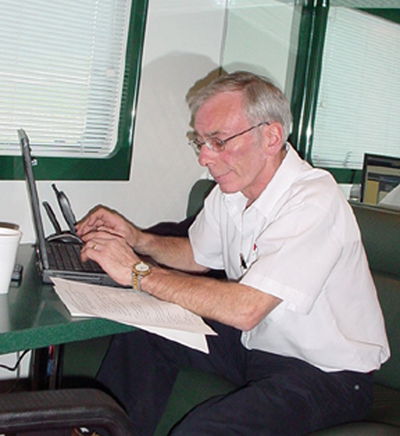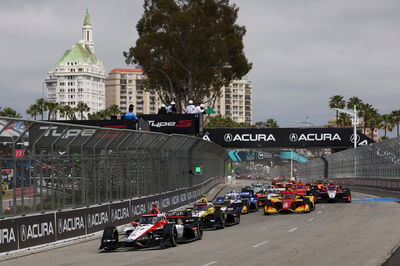Q&A: Patrick Carpentier.
Patrick Carpentier heads into the 2002 season having finally got that elusive first CART victory under his belt but, like his rivals, will have to contend with a host of rule changes. Here's what he had to say about the revised regulations....
Q:
Patrick, first of all let's talk about the introduction of traction control. How do you think it is going to affect the cars and the racing?
Patrick Carpentier heads into the 2002 season having finally got that elusive first CART victory under his belt but, like his rivals, will have to contend with a host of rule changes. Here's what he had to say about the revised regulations....
Q:
Patrick, first of all let's talk about the introduction of traction control. How do you think it is going to affect the cars and the racing?
Patrick Carpentier:
For sure, it's going to be different, very different. The car set-up will be different. We're going to be able to use a lot more front of the car without having the car extremely loose as we exit the corners because it's going to be controlled by computer. So it
makes it, I'd say, a little bit easier to drive, but it also makes it more equal for everybody.
Q:
My understanding is that the traction control was really already built into the engines, but the factories, they turn it off, so it should be pretty easy to turn on?
PC:
Yeah, it's easy. Everybody has it built in.
Q:
So my question is do you think some of the teams were using it before?
PC:
I know a lot of the teams used it in the winter testing. At Homestead - where our pits were down in the corner, the most difficult corner of that track - it definitely showed who had it and who did not. I think what is happening is that a lot of guys were practising with it in case it was going to be made legal. I don't think they would have used it in the race weekend. If they would have, it would have been extremely difficult to find out. But that's why they made it legal, I think they knew it was coming.
Q:
I was talking to Rick Schaffer the other day and he was telling me about how you were a champion speed skater in your youth. And I wonder, at this time of year with the Olympics and everything, do you kind of think if you had gone down that path.... - can you just talk a little bit about your skating career?
PC:
Yeah, I skated for many years. I skated for eight years. I was a member of a team in Canada, but it was before indoor track speed skating was admitted into the Olympics. I used to train all summer and all winter. The reason I started racing cars was I thought I was never going to have to train anymore. I was wrong there, but it gave me a break for a couple of years. I have to train really hard for speed skating.
Actually, I went to a few Olympics, and these guys have won the Canadian championship and two North American indoor speed skating on the short track. And it's a great sport, a lot of action. Actually, I learned a lot about the oval.
Q:
So ovals are nothing new to you?
PC:
I was born on them! A little bit more speed today, though.
Q:
Talk to me about your style, as well as Alex [Tagliani]'s, and how you adapted when the tyres got harder. And then going forward with the traction control, if you think there will be a similar adjustment?
PC:
Yeah, for sure there's going to be an adjustment, because I think it's going to be very different. CART cars, if I make the comparison with Formula Atlantic, which is a light car with not a lot of power and a lot of traction, which will be similar, I guess, to an Indy car with traction control or a Champcar.
What happened is that with these cars, now especially like you said there is no tyre sidewall - it was getting very difficult to apply the power at the corner, especially circuits like Vancouver, Houston, Long Beach, where it is a little bit more slippery and more difficult. It took, I'd say, a little bit of a different driving style. You had to go, to approach the corner really fast, really go as deep as you could, and the speed in the middle of the corner did not matter because everybody seemed to be doing the same speed anyway. And since we could not apply the power down at the exit, the entrance was very important.
So this year, I think it's going to change a lot. And I'm actually pretty happy for myself because I've always liked to use the power and apply the power, if you say more with the rear wheels than the front wheels. I feel I got more success in Atlantic, and with the traction control there, I think it's going to allow me drive more the style that I would like to. So that's going to be interesting.
Q:
Race drivers know that the sport is more mental than physical. I'm interested in your approach. Apparently, painted on the back of your helmet is a Shaolin Temple and you're very much into meditation. Tell me more about that and how that relates to you driving the race car....
PC:
Actually, meditation helps me to be focused. I did quite a bit of martial arts before. I don't do martial arts anymore, but it's something that seems to help me to focus a little bit more and to be more calm, especially during the races and the race weekend.
I used to do it every day, but I don't do it as much anymore, because I don't feel as much of a need to do it. But I do it quite often, and for some reason for me, it helps me to calm down and rest a little bit more, and just to get my ideas and emotions and things together more easily. It's something that I've always felt is something that's always helped me. I know for some people sitting down and breathing and just focusing on one thought is something that they like to do, but for me it's something that helps me quite a bit.
Q:
What's the significance of the temple in China?
PC:
Nothing special. It's always because I liked Zen meditation, and I guess that's where it originated. I put the castle on the back, because my helmet contains all different events of my life and different the parts of my life. If you go through it, it's got the FA team that we raced against, it's got #7; different colours, blue, because when I got hired by Player's, I went to the highest step on the podium; and the white for purity. So everything on the helmet is something that I lived through or something that was the past. And the temple I just keep there because I had it at that point in my life.
Q:
There were a number of rules changes announced at Laguna Seca in regards to competition and making it more exciting for the fans, how do you feel about the announcements that were made in terms of competition and making the show better; do you feel that was the right direction?
PC:
Yes, I do. I've been actually - if you want to call it that - one of the complainers of the last few years about the way the qualifying procedure used to work. I was really impressed by what Lee [Dykstra] and Wally [Dallenbach] could turn around just in one week, and I think they changed more things in the past spring training weekend than we have changed in the last five years.
So I was really happy - and it's funny because you walk down the pit-lane now and it's like a new place - everybody is smiling and everybody is anxious and up for it and they want to start the season.
I think what they have done with the qualifying situation is good, every driver has to be happy about it. It's going to be a lot more fair than what it used to be. Everybody is going to have the same track although these guys are going to explain more what the rules are. But everybody is going to have the same track time. Everybody is going to be on the track on Friday afternoon at the same time and Saturday afternoon at the same time. And I don't think the track is going to be too crowded because we have a maximum amount of 15 laps that we are allowed to do.
And the guy who is going to be the fastest on Friday is going to get some points, and he is going to be assured to be on the front row. And the guy who is fastest on Saturday, if he is faster than the guy on Friday, will get the pole and will also get some points. Both days will be important, and there will be some points to grab, and it will be very interesting. I think it's going to be a great show, especially because they are going to have TV on Friday nights and stuff like that. I think what's coming for the CART series is going to be fantastic.
Q:
What's your opinion of finishing the race under green with the new rules? If they red-flag the race toward the end of the race, will your strategy now change to save fuel, make sure you have enough in case a red flag were to come out at the end?
PC:
Oh, yeah, it's going to change, for sure. It's going to be very definitive. Take Fontana, where we race for $1million and the race ends up under a yellow flag. I don't think it's very interesting and I don't think it's fair, and I don't think it's good for the fans.
You know, some races, it's going to be unfair to me or to someone else because it ended on the green. But some other race, I might be the lucky one that's going to win it and have a good strategy because it ended on the green. But for the show, no doubt about it; it's a lot better finish on the green.











